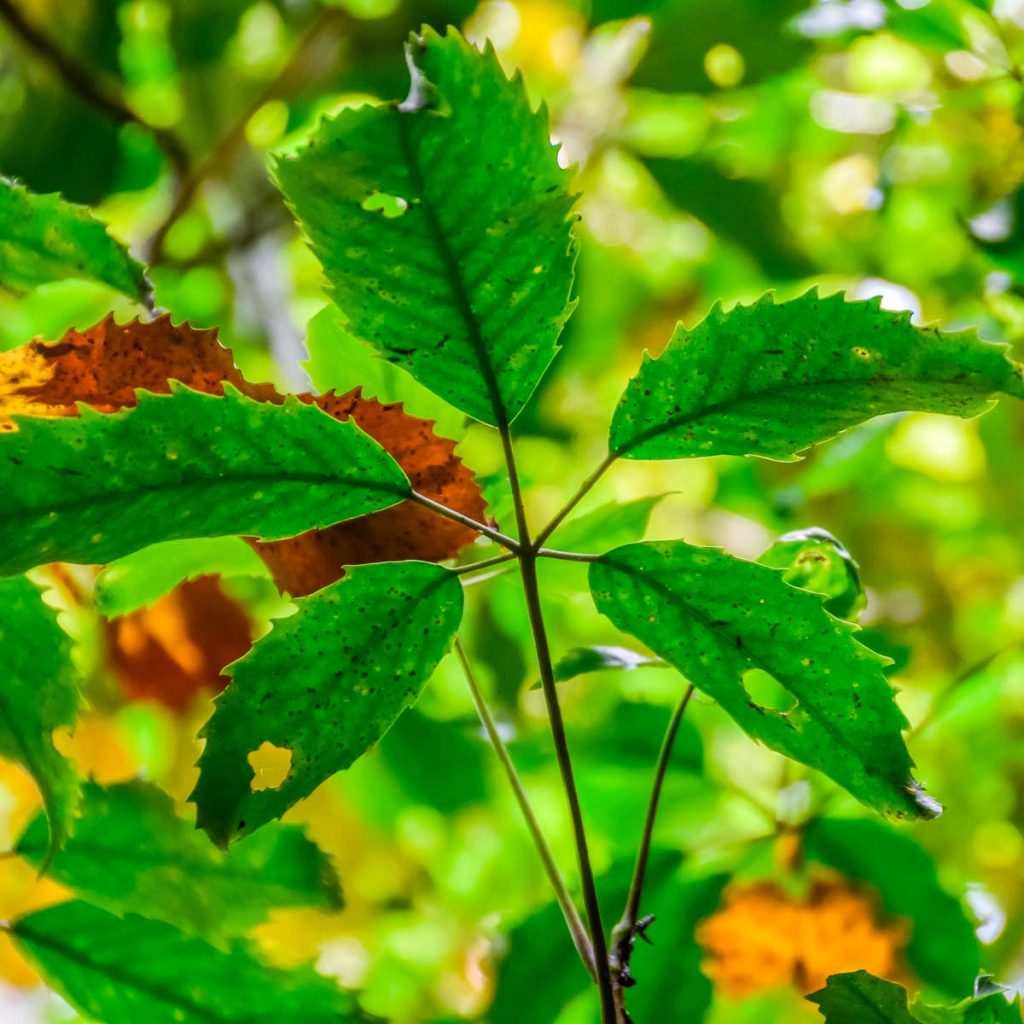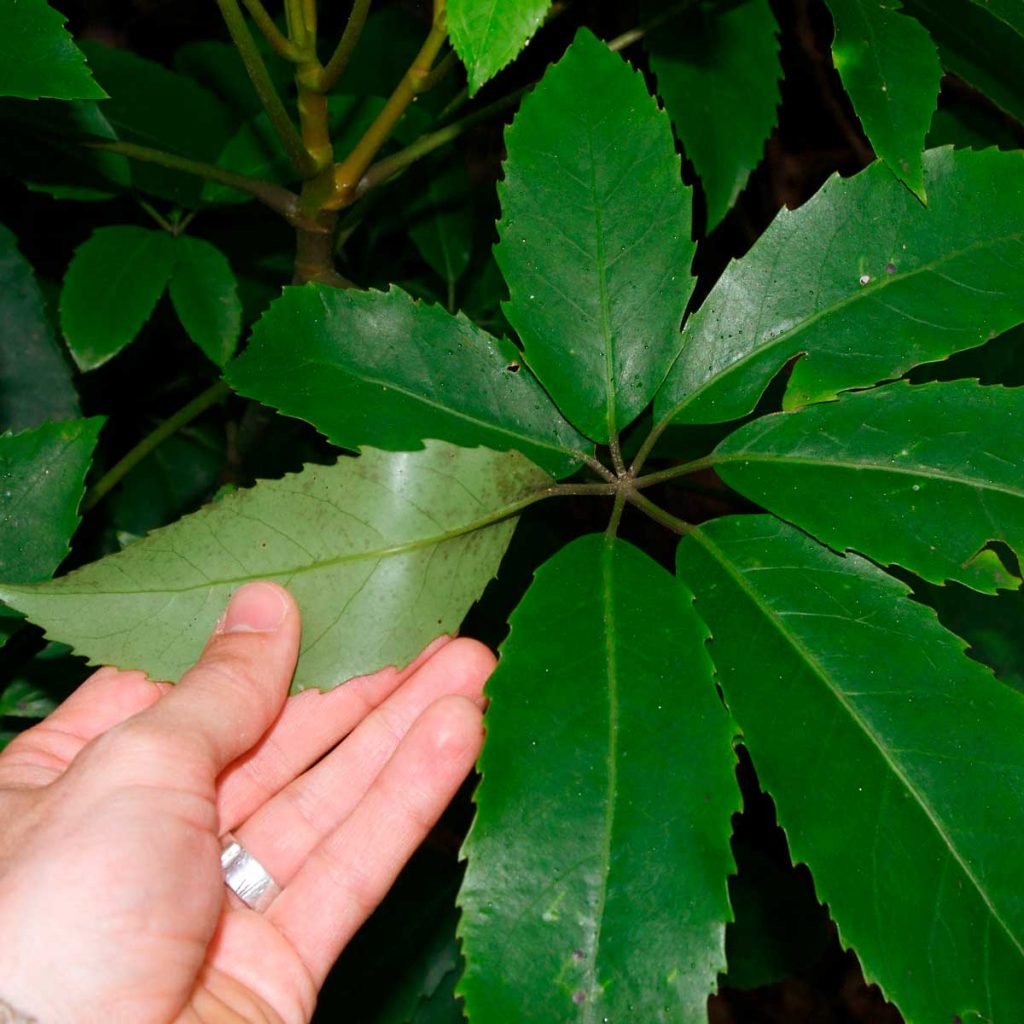
Trees / Five Finger
Information for Juniors
Five Finger
- Five-finger is common as a pioneer in forest regrowth.
- Found throughout the North and South Islands in lowland forests and shrubland.
- It grows up to Sm tall with trunk up to 30cm in
diameter.
Bark & Foliage
⦁ The young bark is brown and smooth with prominent leaf scars, it becomes rough with age.
⦁ Leaves are large, thick and shiny on the upper surface with 5- 7 leaflets, the leaf stalk is up to 20cm long with a well developed, swollen sheath partly enclosing the stem.
Flowers and Seeds
⦁ Flowers are large, male and female flowers are on separate trees although male trees sometimes have female flowers too.
⦁ Flowers are up to 5mm in diameter opening during winter from conspicuous red-purple buds.
⦁ Fruits are berry like almost black, slightly flattened, with 2 seeds, they ripen from spring to summer
⦁ Pollination is by insects and seed dispersal by birds.
Interesting Facts
⦁ The gum was used in join of water vessels to prevent leakage.
⦁ The bark was sometime used to make small water vessels and used when green to make skids for hauling canoes.
⦁ Waiapu natives say that the wood taken from trees growing in exposed conditions was used for fashioning flutes.


Information for Junior Secondary
Five Finger
- Five-finger is common as a pioneer in forest regrowth.
- Found throughout the North and South Islands in lowland forests and shrubland.
- It grows up to Sm tall with trunk up to 30cm in
diameter.
Bark & Foliage
⦁ The young bark is brown and smooth with prominent leaf scars, it becomes rough with age.
⦁ Leaves are large, thick and shiny on the upper surface with 5- 7 leaflets, the leaf stalk is up to 20cm long with a well developed, swollen sheath partly enclosing the stem.
Flowers and Seeds
⦁ Flowers are large, male and female flowers are on separate trees although male trees sometimes have female flowers too.
⦁ Flowers are up to 5mm in diameter opening during winter from conspicuous red-purple buds.
⦁ Fruits are berry like almost black, slightly flattened, with 2 seeds, they ripen from spring to summer
⦁ Pollination is by insects and seed dispersal by birds.
Interesting Facts
⦁ The gum was used in join of water vessels to prevent leakage.
⦁ The bark was sometime used to make small water vessels and used when green to make skids for hauling canoes.
⦁ Waiapu natives say that the wood taken from trees growing in exposed conditions was used for fashioning flutes.


Information for Seniors
Five Finger
- Five-finger is common as a pioneer in forest regrowth.
- Found throughout the North and South Islands in lowland forests and shrubland.
- It grows up to Sm tall with trunk up to 30cm in
diameter.
Bark & Foliage
⦁ The young bark is brown and smooth with prominent leaf scars, it becomes rough with age.
⦁ Leaves are large, thick and shiny on the upper surface with 5- 7 leaflets, the leaf stalk is up to 20cm long with a well developed, swollen sheath partly enclosing the stem.
Flowers and Seeds
⦁ Flowers are large, male and female flowers are on separate trees although male trees sometimes have female flowers too.
⦁ Flowers are up to 5mm in diameter opening during winter from conspicuous red-purple buds.
⦁ Fruits are berry like almost black, slightly flattened, with 2 seeds, they ripen from spring to summer
⦁ Pollination is by insects and seed dispersal by birds.
Interesting Facts
⦁ The gum was used in join of water vessels to prevent leakage.
⦁ The bark was sometime used to make small water vessels and used when green to make skids for hauling canoes.
⦁ Waiapu natives say that the wood taken from trees growing in exposed conditions was used for fashioning flutes.


Activities
- TBS
